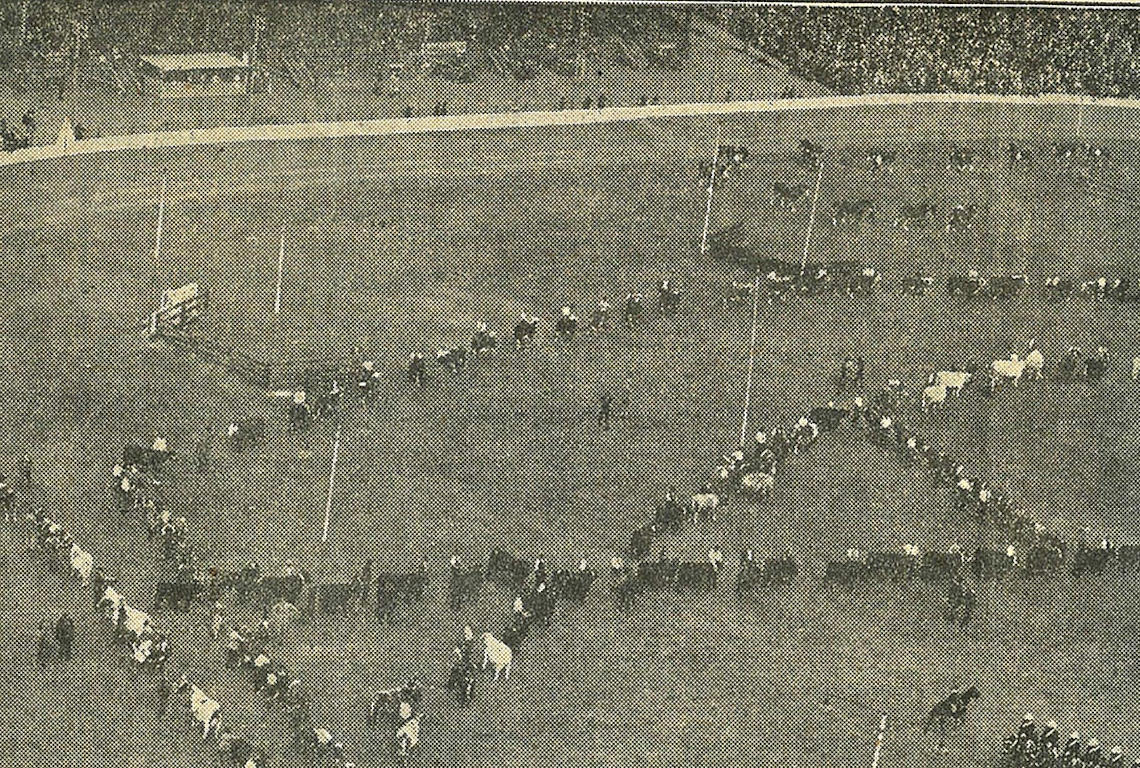Opening of the Sydney Harbour Bridge Heritage Highlight

When the Sydney Harbour Bridge opened in 1932 many big public celebrations were planned. To help organise them, authorities turned to staff at the Royal Agricultural Society of NSW.
When the New South Wales State Government began planning public celebrations for the long-awaited opening of the Sydney Harbour Bridge, it immediately turned for assistance to the Royal Agricultural Society of NSW. It stood to reason: the RAS had a proven track record, successfully organising and delivering the biggest event in the country – the annual Sydney Royal Easter Show.
The construction of the bridge was a colossal achievement and a source of great national pride. To do it justice the festivities would have to be spectacular.
A Sydney Carnival Week Executive Committee was formed on 10 September 1931 to get everything ready for the bridge opening on 19 March the following year. The Lord Mayor welcomed everyone to the meeting and immediately vacated the chair, turning it over to the charismatic president of the RAS, Sir Samuel Hordern. Sub-committees were formed covering various areas: Finance, Transport, Sport, Publicity, Pageantry and Historical, Primary Producers, Churches, Programming, and Arts and Music. Nine RAS Councillors and staff members served on these committees, lending their expertise. Chief among them was the talented senior administrator of the RAS, Lt Col GC Somerville, who took on the same role for the Carnival Week Executive, becoming its honorary secretary.
Committees were provided with office space at the Moore Park Showground; a generous gesture, but a convenient one for those members who also had duties with the RAS. There was still a Show to organise – a Show that would open only two days after the bridge, and which would also honour the new icon.
When Carnival Week finally arrived, it was a wild success. The city went crazy with themed events. There were commemorative sporting matches (including a miniature amateur Olympic Games in Manly), there were musical and artistic performances, and countless parties and balls. On the day itself a gigantic procession crossed the Bridge after the opening ceremony. It featured themed floats highlighting different aspects of Australian life, including all agricultural sectors. Bands marched in between, along with workers and representatives from a multitude of organisations. In the air, planes flew over, while below, boats took part in a water procession. At night, the harbour was transformed into a Venetian carnival, and fireworks lit the city.
At the Show, there were thousands of extra visitors, who had come to Sydney to witness history in the making. Display space was at a premium, and a record number of exhibitors entered competitions. Every aspect of the Show was ramped up a notch, but in the main arena the RAS had one magnificent surprise in store for the public. It was a Grand Parade of cattle in the shape of the bridge. The arch was formed by Herefords, the roadway by Shorthorns and Devons, and the decking by Aberdeen Angus cattle. Ayrshires formed the pylons, Jerseys and Guernseys made up the approaches, while the champion bull of the Show linked the arches. The usual patterns of the venerable Grand Parade had been altered for good cause.
When all the festivities were finally over, the RAS and its personnel were thanked by the Government for their efforts. The close working relationship enjoyed by the two entities demonstrates just how important the RAS and the Show was to NSW, socially and economically.
RAS Councillors and staff who officially assisted on Sydney Carnival Week committees:
• Sir Samuel Hordern, chairman of the Executive Committee
• Mr JHS Angus on the Finance Sectional Committee.
• Mr AW Skidmore on the Finance Sectional Committee.
• Mr WH Childs (also Commissioner of Police Council) on the Transport Sectional Committee.
• Mr RF Wyly (also Manager and Secretary of the Sydney Cricket Ground Council) on the Sporting Sectional Committee.
• Mr WH Whiddon (listed as Chairman of Tattersall’s Club) on the Sporting Sectional Committee.
• Mr EJ Rafferty on the Publicity Sectional Committee.
• Mr J Bailey (also of the Australian Workers’ Union) on the Pageantry & Historical Sectional Committee.
• WF Dunn (also Minister for Agriculture, and Deputy Chairman of the RAS of NSW at the time) acting as Chairman on the Primary Producers Sectional Committee.
• Lt Col GC Somerville who assisted on all the celebration committees, and who was officially listed as the Honorary Secretary of the Executive Committee on the 26 October 1931 meeting.